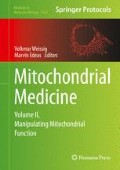Abstract
Mitochondrial retrograde signaling is a mitochondria-to-nucleus communication pathway, conserved from yeast to humans, by which dysfunctional mitochondria relay signals that lead to cell stress adaptation in physiopathological conditions by changes in nuclear gene expression. The best comprehension of components and regulation of retrograde signaling have been obtained in Saccharomyces cerevisiae, where retrograde target gene expression is regulated by RTG genes. In this chapter, we describe the methods to measure mitochondrial retrograde pathway activation in yeast cells by monitoring the mRNA levels of RTG target genes, such as those encoding for peroxisomal citrate synthase, aconitase, and NAD+-specific isocitrate dehydrogenase subunit 1, as well as the phosphorylation status of Rtg1/3p transcriptional factor which controls RTG target gene transcription.
Access this chapter
Tax calculation will be finalised at checkout
Purchases are for personal use only
References
Portt L, Norman G, Clapp C et al (2011) Anti-apoptosis and cell survival: a review. Biochim Biophys Acta 1813:238–259
Wang C, Youle RJ (2009) The role of mitochondria in apoptosis*. Annu Rev Genet 43:95–118
Ryan MT, Hoogenraad NJ (2007) Mitochondrial-nuclear communications. Annu Rev Biochem 76:701–722
Liu Z, Butow RA (2006) Mitochondrial retrograde signaling. Annu Rev Genet 40:159–185
Liao XS, Small WC, Srere PA et al (1991) Intramitochondrial functions regulate nonmitochondrial citrate synthase (CIT2) expression in Saccharomyces cerevisiae. Mol Cell Biol 11:38–46
Jia Y, Rothermel B, Thornton J et al (1997) A basic helix-loop-helix-leucine zipper transcription complex in yeast functions in a signaling pathway from mitochondria to the nucleus. Mol Cell Biol 17:1110–1117
Bork P, Sander C, Valencia A (1992) An ATPase domain common to prokaryotic cell cycle proteins, sugar kinases, actin, and hsp70 heat shock proteins. Proc Natl Acad Sci U S A 89:7290–7294
Koonin EV (1994) Yeast protein controlling inter-organelle communication is related to bacterial phosphatases containing the Hsp 70-type ATP-binding domain. Trends Biochem Sci 19:156–157
Liu Z, Sekito T, Spirek M et al (2003) Retrograde signaling is regulated by the dynamic interaction between Rtg2p and Mks1p. Mol Cell 12:401–411
Butow RA, Avadhani NG (2004) Mitochondrial signaling: the retrograde response. Mol Cell 14:1–15
Guha M, Avadhani NG (2013) Mitochondrial retrograde signaling at the crossroads of tumor bioenergetics, genetics and epigenetics. Mitochondrion 13:577–591
Jazwinski SM, Kriete A (2012) The yeast retrograde response as a model of intracellular signaling of mitochondrial dysfunction. Front Physiol 3:139
Guaragnella N, Zdralevic M, Lattanzio P et al (2013) Yeast growth in raffinose results in resistance to acetic-acid induced programmed cell death mostly due to the activation of the mitochondrial retrograde pathway. Biochim Biophys Acta 1833:2765–2774
Cuezva JM, Ortega AD, Willers I et al (2009) The tumor suppressor function of mitochondria: translation into the clinics. Biochim Biophys Acta 1792:1145–1158
Compton S, Kim C, Griner NB et al (2011) Mitochondrial dysfunction impairs tumor suppressor p53 expression/function. J Biol Chem 286:20297–20312
Carmona-Gutierrez D, Eisenberg T, Buttner S et al (2010) Apoptosis in yeast: triggers, pathways, subroutines. Cell Death Differ 17:763–773
Mager WH, Winderickx J (2005) Yeast as a model for medical and medicinal research. Trends Pharmacol Sci 26:265–273
Greenwood MT, Ludovico P (2009) Expressing and functional analysis of mammalian apoptotic regulators in yeast. Cell Death Differ 17:737–745
Giannattasio S, Guaragnella N, Arbini AA et al (2013) Stress-related mitochondrial components and mitochondrial genome as targets of anticancer therapy. Chem Biol Drug Des 81:102–112
Dilova I, Powers T (2006) Accounting for strain-specific differences during RTG target gene regulation in Saccharomyces cerevisiae. FEMS Yeast Res 6:112–119
Giannattasio S, Liu Z, Thornton J et al (2005) Retrograde response to mitochondrial dysfunction is separable from TOR1/2 regulation of retrograde gene expression. J Biol Chem 280:42528–42535
Liao X, Butow RA (1993) RTG1 and RTG2: two yeast genes required for a novel path of communication from mitochondria to the nucleus. Cell 72:61–71
Epstein CB, Waddle JA, Hale WT et al (2001) Genome-wide responses to mitochondrial dysfunction. Mol Biol Cell 12:297–308
Miceli MV, Jazwinski SM (2005) Common and cell type-specific responses of human cells to mitochondrial dysfunction. Exp Cell Res 302:270–280
Sekito T, Thornton J, Butow RA (2000) Mitochondria-to-nuclear signaling is regulated by the subcellular localization of the transcription factors Rtg1p and Rtg3p. Mol Biol Cell 11:2103–2115
Acknowledgments
Rtg3p antibody was kindly provided by Dr. Z. Liu, University of New Orleans, New Orleans (USA). This work has been funded by grants from project FIRB-MERIT RBNE08HWLZ and the Italian Ministry of Economy and Finance to the CNR for the Project “FaReBio di Qualità.” M.Ž. is a recipient of a CNR Ph.D. fellowship in Biology and Biotechnologies, University of Salento, Lecce, Italy.
Author information
Authors and Affiliations
Corresponding author
Editor information
Editors and Affiliations
Rights and permissions
Copyright information
© 2015 Springer Science+Business Media New York
About this protocol
Cite this protocol
Ždralević, M., Guaragnella, N., Giannattasio, S. (2015). Yeast as a Tool to Study Mitochondrial Retrograde Pathway En Route to Cell Stress Response. In: Weissig, V., Edeas, M. (eds) Mitochondrial Medicine. Methods in Molecular Biology, vol 1265. Humana Press, New York, NY. https://doi.org/10.1007/978-1-4939-2288-8_22
Download citation
DOI: https://doi.org/10.1007/978-1-4939-2288-8_22
Publisher Name: Humana Press, New York, NY
Print ISBN: 978-1-4939-2287-1
Online ISBN: 978-1-4939-2288-8
eBook Packages: Springer Protocols

